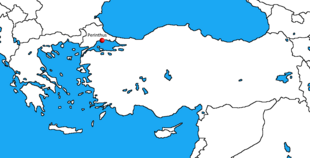
Amyntas III was king of the ancient Greek kingdom of Macedonia from 393/2 to 388/7 BC and again from 387/6 to 370 BC. He was a member of the Argead dynasty through his father Arrhidaeus, a son of Amyntas, one of the sons of Alexander I. His most famous son is Philip II, father of Alexander the Great.
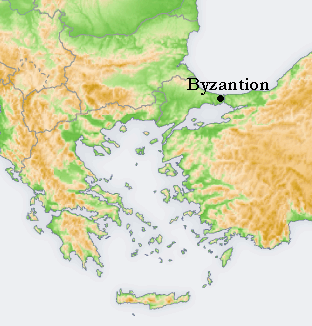
Byzantium or Byzantion was an ancient Greek city in classical antiquity that became known as Constantinople in late antiquity and Istanbul today. The Greek name Byzantion and its Latinization Byzantium continued to be used as a name of Constantinople sporadically and to varying degrees during the thousand year existence of the Eastern Roman Empire, which was commonly referred to by the former name of that city, the Byzantine Empire. Byzantium was colonized by Greeks from Megara in the 7th century BC and remained primarily Greek-speaking until its conquest by the Ottoman Empire in AD 1453.

Macedonia, also called Macedon, was an ancient kingdom on the periphery of Archaic and Classical Greece, which later became the dominant state of Hellenistic Greece. The kingdom was founded and initially ruled by the royal Argead dynasty, which was followed by the Antipatrid and Antigonid dynasties. Home to the ancient Macedonians, the earliest kingdom was centered on the northeastern part of the Greek peninsula, and bordered by Epirus to the southwest, Illyria to the northwest, Paeonia to the north, Thrace to the east and Thessaly to the south.
This article concerns the period 349 BC – 340 BC.
This article concerns the period 369 BC – 360 BC
This article concerns the period 359 BC – 350 BC.
This article concerns the period 339 BC – 330 BC.

This article concerns the period 329 BC – 320 BC.

This is a timeline of ancient Greece from its emergence around 800 BC to its subjection to the Roman Empire in 146 BC.

Philip II of Macedon was the king (basileus) of the ancient kingdom of Macedonia from 359 BC until his death in 336 BC. He was a member of the Argead dynasty, founders of the ancient kingdom, and the father of Alexander the Great.
Year 344 BC was a year of the pre-Julian Roman calendar. At the time it was known as the Year of the Consulship of Rutilus and Torquatus. The denomination 344 BC for this year has been used since the early medieval period, when the Anno Domini calendar era became the prevalent method in Europe for naming years.
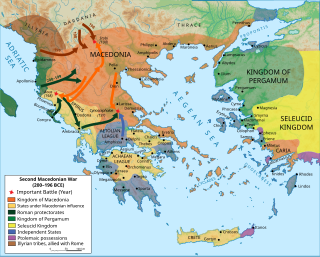
The Second Macedonian War was fought between Macedon, led by Philip V of Macedon, and Rome, allied with Pergamon and Rhodes. Philip was defeated and was forced to abandon all possessions in southern Greece, Thrace and Asia Minor. During their intervention, although the Romans declared the "freedom of the Greeks" against the rule from the Macedonian kingdom, the war marked a significant stage in increasing Roman intervention in the affairs of the eastern Mediterranean, which would eventually lead to Rome's conquest of the entire region.

Antipater was a Macedonian general and statesman under the successive kingships of Philip II of Macedon and his son, Alexander the Great. In the wake of the collapse of the Argead house, his son Cassander would eventually come to rule Macedonia as a king in his own right.

Ochus, known by his dynastic name Artaxerxes III, was King of Kings of the Achaemenid Empire from 359/58 to 338 BC. He was the son and successor of Artaxerxes II and his mother was Stateira.
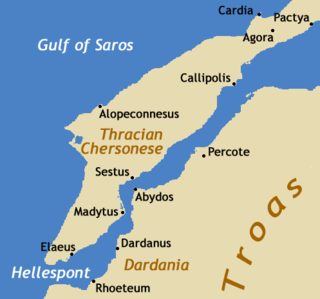
Sestos was an ancient city in Thrace. It was located at the Thracian Chersonese peninsula on the European coast of the Hellespont, opposite the ancient city of Abydos, and near the town of Eceabat in Turkey.
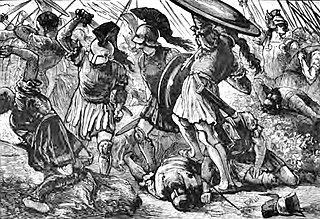
The Battle of Chaeronea was fought in 338 BC, near the city of Chaeronea in Boeotia, between Macedonia under Philip II and an alliance of city-states led by Athens and Thebes. The battle was the culmination of Philip's final campaigns in 339–338 BC and resulted in a decisive victory for the Macedonians and their allies.
Cersobleptes was the son of Cotys I, king of the Odrysians in Thrace, on whose death in September 360 BC he inherited the throne.

The Cretan War was fought by King Philip V of Macedon, the Aetolian League, many Cretan cities and Spartan pirates against the forces of Rhodes and later Attalus I of Pergamum, Byzantium, Cyzicus, Athens, and Knossos.

Under the reign of Philip II, the ancient kingdom of Macedonia, initially at the periphery of classical Greek affairs, came to dominate Ancient Greece in the span of just 25 years, largely thanks to the character and policies of its king. In addition to utilising effective diplomacy and marriage alliances to achieve his political aims, Philip II was responsible for reforming the ancient Macedonian army into an effective fighting force. The Macedonian phalanx became the hallmark of the Macedonian army during his reign and the subsequent Hellenistic period. His army and engineers also made extensive use of siege engines. Chief among Philip's Thracian enemies was the ruler Kersebleptes, who may have coordinated a temporary alliance with Athens. In a series of campaigns stretching from 356 to 340 BC, Philip II managed to ultimately subjugate Kersebleptes as a tributary vassal, conquering much of Thrace in the process. Philip II also fought against the Illyrian king Bardylis, who threatened Macedonia proper, and against Grabos II and Pleuratus in Illyria. In his newly conquered territories, he founded new cities such as Philippi, Philippopolis, Herakleia Sintike, and Herakleia Lynkestis.

The kingdom of Macedonia was an ancient state in what is now the Macedonian region of northern Greece, founded in the mid-7th century BC during the period of Archaic Greece and lasting until the mid-2nd century BC. Led first by the Argead dynasty of kings, Macedonia became a vassal state of the Achaemenid Empire of ancient Persia during the reigns of Amyntas I of Macedon and his son Alexander I of Macedon. The period of Achaemenid Macedonia came to an end in roughly 479 BC with the ultimate Greek victory against the second Persian invasion of Greece led by Xerxes I and the withdrawal of Persian forces from the European mainland.
